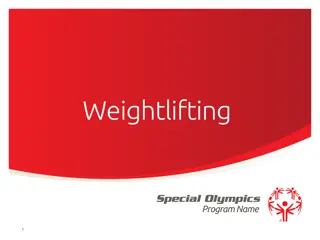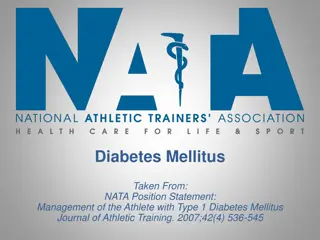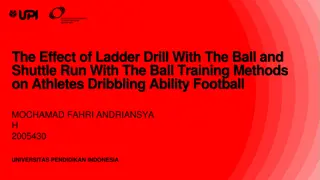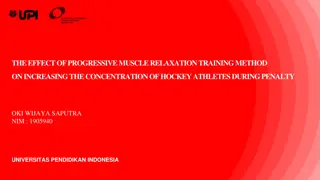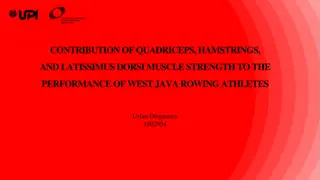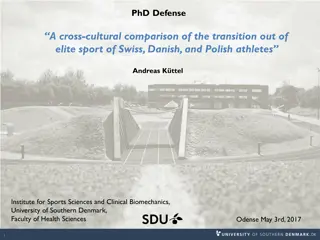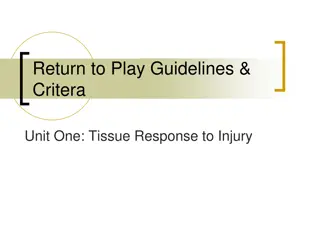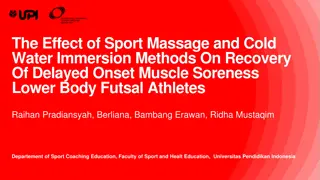Various Types of Training for Athletes
Identify and explore different training methods such as Continuous, Fartlek, Interval, and Circuit training to enhance athletic performance, focusing on improving aerobic endurance, flexibility, strength, speed, and overall fitness levels. Learn how athletes can strategically utilize each training type for optimal results in their chosen sport.
Download Presentation

Please find below an Image/Link to download the presentation.
The content on the website is provided AS IS for your information and personal use only. It may not be sold, licensed, or shared on other websites without obtaining consent from the author.If you encounter any issues during the download, it is possible that the publisher has removed the file from their server.
You are allowed to download the files provided on this website for personal or commercial use, subject to the condition that they are used lawfully. All files are the property of their respective owners.
The content on the website is provided AS IS for your information and personal use only. It may not be sold, licensed, or shared on other websites without obtaining consent from the author.
E N D
Presentation Transcript
TYPES OF TRAINING C A N Y O U I DENTI F Y THE A DVA NTA GES A ND DI SA DVA NTA GES?
DIFFERENT CATEGORIES OF TRAINING TYPES Aerobic endurance training: Flexibility training: Strength, muscular endurance and power training: Speed training:
CONTINUOUS TRAINING Continuous training involves working for a sustained period of time without rest. This is training at a steady pace and moderate intensity for a minimum period of 30 minutes. It can involve any form of heart raising activity that takes place over an extended period of time. It improves Aerobic Endurance. Explain how an athlete of your choice would use continuous training to improve performance in their chosen sport? (3)
FARTLEK TRAINING Fartlek training or 'speed play' training is where the intensity of training is varied by running at different speeds or over different terrain. The training has no static rest period. It is important to know about other ways in which intensity of training can be increased, including the use of equipment (harness, running with weights or weighted backpack). It improves Aerobic and Anaerobic fitness depending on the duration of work periods. It is commonly used by games players. Explain how an athlete of your choice would use fartlek training to improve performance in their chosen sport?(3)
INTERVAL TRAINING Interval training involves alternating between periods of hard exercise and rest. This is where the individual performs a work period followed by a rest or recovery period. Typical work time when using it aerobically can vary from training for 30 seconds to five minutes. Recovery periods can be complete rest, walking or light jogging. Shuttle runs of varied distances are a common form of interval training. Typical work intervals for aerobic endurance will be around 60% maximum oxygen uptake (VO2 max). Decrease the number of rest periods and decrease work intensity to develop aerobic endurance. It can also improves speed and muscular endurance. Explain how an athlete of your choice would use interval training to improve performance in their chosen sport? (3)
CIRCUIT TRAINING Circuit training involves performing a series of exercises in a special order called a circuit. Each activity takes place at a 'station'. The different stations/exercises are used to develop aerobic endurance. The station order/order of exercises is important to ensure different muscle groups are used to avoid fatigue. The number of stations, time spent at each station, number of circuits, rest period between exercises and number of circuit sessions per week can be varied. It can also be designed to improve speed, agility, co- ordination, balance and muscular endurance. Explain how an athlete of your choice would use circuit training to improve aerobic endurance for their chosen sport? (3)
FLEXIBILITY TRAINING Static: There are two types of static flexibility training. Firstly active stretching, which is performed independently where the performer applies internal force to stretch and lengthen the muscle. The second is passive stretching, also known as assisted stretching, which requires the help of another person or an object such as a wall. The other person/object applies external force causing the muscle to stretch.
FLEXIBILITY TRAINING Ballistic [Dynamic]: This is where the performer makes fast, jerky movements through the complete range of motion, usually in the form of bobbing or bouncing. Ballistic stretching is specific to the movement pattern of the sport/activity to be performed. It needs to be undertaken with care as the technique can cause muscle soreness and strains.
FLEXIBILITY TRAINING Proprioceptive Neuromuscular Facilitation (PNF) technique: This is used to develop mobility, strength and flexibility. The technique may be performed with the help of a partner or alternatively by using an immovable object (as resistance to inhibit movement). PNF stretches can be used in rehabilitation programmes. To perform the PNF technique with a partner, the performer should stretch the muscle to the upper limit of its range of movement and then, with the help of a partner, hold the muscle in an isometric contraction, where there is no active shortening or lengthening of the muscle, for 6 10 seconds. Following this, relax the muscle and with the help of a partner a static (passive) stretch is performed to enable the muscle to stretch even further. The technique inhibits the stretch reflex which occurs when a muscle is stretched to its full capability, so that an even greater stretch and range of movement can occur.
QUESTIONS To perform well hurdlers have to develop their flexibility. Explain why hurdlers would use ballistic and proprioceptive neuromuscular facilitation (PNF) stretching to improve their performance? (4) Explain one reason why the hurdler may choose not to use static active stretching? (2)
STRENGTH, MUSCULAR ENDURANCE AND POWER TRAINING: Weight training uses weights to provide resistance to the muscles. It improves Muscular Strength (high weight, low reps) Muscular Endurance (low weight, high reps, many sets) Explosive Power (medium weight and reps performed quickly).
FREE WEIGHTS Free weights include dumbbells, barbells, medicine balls, sandbells, and kettlebells. Unlike weight machines, they do not constrain users to specific, fixed movements, and therefore require more effort from the individual's stabilizer muscles. It is often argued that free weight exercises are superior for precisely this reason. However it can be easy to lose form and technique when using free weights and injury can be incurred if exercises are not performed correctly.
FREE WEIGHTS The free weights identified in the previous slide can be used to perform different types of dynamic exercises. Concepts to use when training for strength (low reps and high loads). Concepts to use when training for endurance (high reps and low loads). Order of exercises: Focus on core exercises (working muscles which help to stabilise the spine and pelvis) before assistance exercises (working muscles associated with the events in a performer s specific sport, Or the main exercises in a training programme if a performer is not training for a specific sport)
FREE WEIGHTS Intensity (% 1 Repetition Maximum 1RM) Training for strength (Muscular) endurance (50 60% 1RM and 20 reps repetitive movements of a muscle or muscle group) Training for elastic (Power) strength (75% 1RM and 12 reps for producing movements in very close succession, like in gymnastics) Training for maximum (Muscular) strength (90% 1RM and 6 reps producing a single movement against a resistance/load), reps, sets, rest period.
PLYOMETRIC TRAINING Also known as "jump training" or "plyos", are exercises in which muscles exert maximum force in short intervals of time, with the goal of increasing power (speed x strength). A plyometric exercise comprises of two phases: Plyometric exercises need maximal force as the muscle lengthens (eccentric action) before an immediate maximal force as the muscle shortens (concentric action). Types of exercises include lunging, bounding, incline press-ups, barrier hopping and jumping. This type of training needs to be performed carefully because it can cause muscle soreness. This type of training develops sport-specific explosive power and strength. It is used by sports performers such as sprinters, hurdlers, and netball, volleyball and basketball players.
CIRCUIT TRAINING This is where different stations/exercises are used to develop strength, muscular endurance and power. The stations/exercises use different muscle groups to avoid fatigue. Activities are performed for short periods of time at maximal intensities to ensure that muscles are working anaerobically at different stations.
SPEED TRAINING Hollow sprints: A series of sprints separated by a hollow period of jogging or walking.
SPEED TRAINING Acceleration Sprints: This is where the pace is gradually increased from a standing or rolling start to jogging, then to striding, and then to a maximum sprint. Different drills can be used, such as resistance drills and hill sprints. Rest intervals of jogging or walking are used in between each repetition.
SPEED TRAINING Interval training: The individual performs a work period followed by a rest or recovery period. When speed training, the work intervals will be shorter and more intense performed at a high intensity, close to maximum than when using it aerobically. Increase the number of rest periods and increase work intensity to develop speed
ADVANTAGES AND DISADVANTAGES Can you list an advantage and disadvantage for each type of training described?




